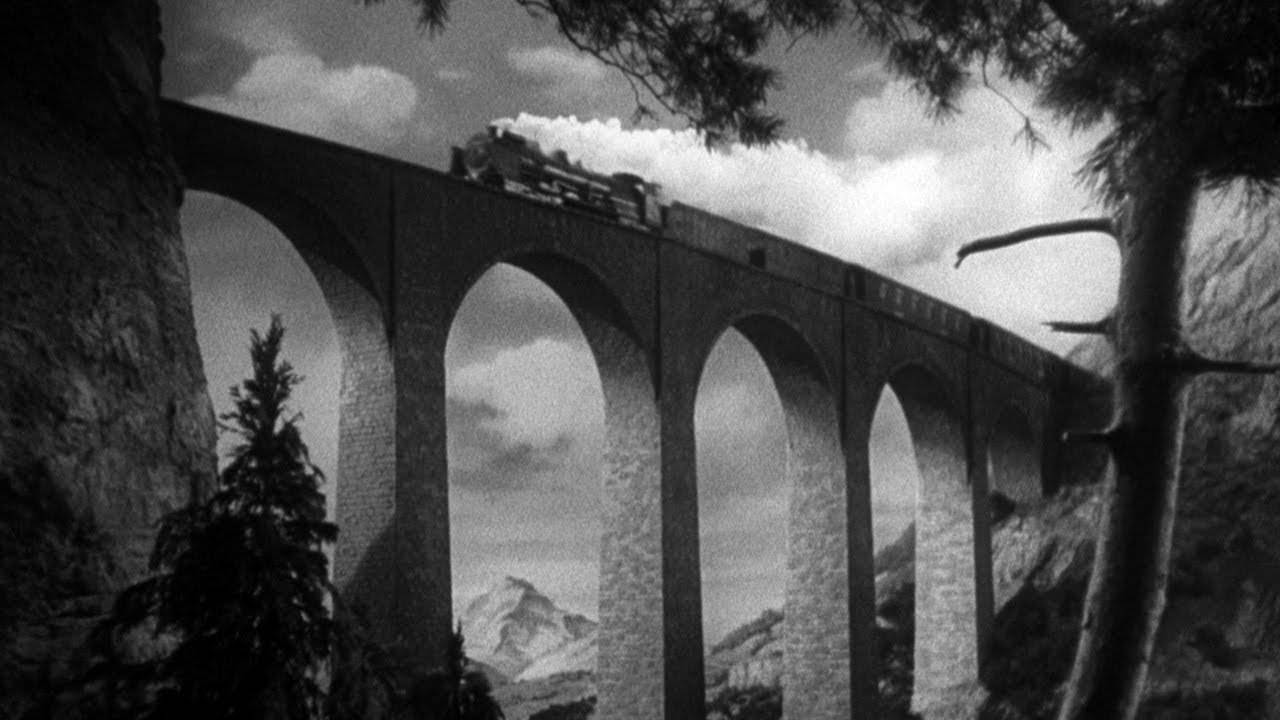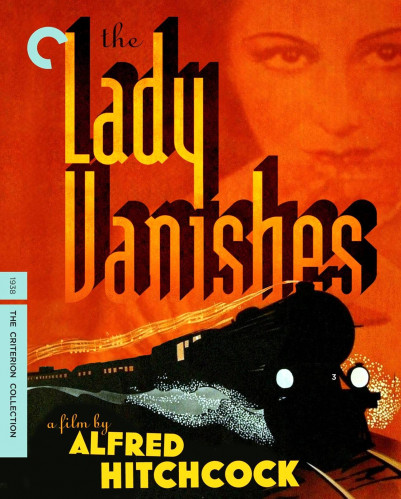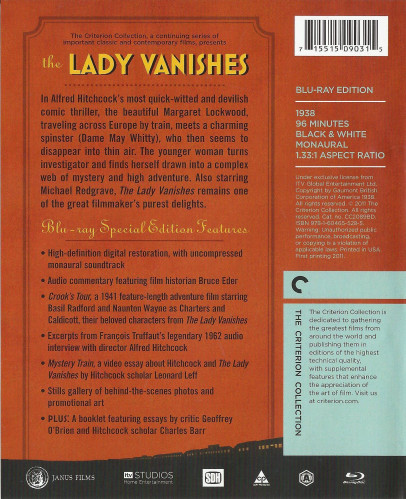THE LADY VANISHES [1938 / 2011] [The Criterion Collection] [Blu-ray] [USA Release]
One of the Greatest Master of Suspense Alfred Hitchcock's Thrillers!
In Alfred Hitchcock's most quick-witted and devilish comic thriller, the beautiful Margaret Lockwood as Iris Matilda Henderson, is traveling across Europe by train, and meets a charming spinster Miss Froy [Dame May Whitty], who then seems to disappear into thin air. The younger woman Iris Matilda Henderson turns investigator and finds herself drawn into a complex web of mystery and high adventure. Also starring Michael Redgrave as Gilbert Redman, and ‘THE LADY VANISHES’ remains one of the great filmmaker's purest delights.
The Criterion Collection is dedicated to gathering the greatest films from around the world and publishing them in editions of the highest technical quality. With supplemental features that enhance the appreciation of the art of film.
FILM FACT No.1: Awards and Nominations: 1939 New York Film Critics Circle Awards: Win: Best Director Alfred Hitchcock. Nominated: Best Film.
FILM FACT No.2: ‘THE LADY VANISHES’ is based upon the novel “The Wheel Spins” by Ethel Lina White. The British Film Institute ranked ‘THE LADY VANISHES’ the 35th best British film of the 20th century. In 2017, a poll of 150 actors, directors, writers, producers and critics for Time Out magazine saw it ranked the 31st best British film ever. It is one of Alfred Hitchcock's most renowned British films, and the first of three screen versions of Ethel Lina White's novel to date. ‘THE LADY VANISHES’ was originally called ‘The Lost Lady,’ and Irish director Roy William Neill was assigned by producer Edward Black to make it. A crew was dispatched to Yugoslavia to do background shots, but when the Yugoslav police accidentally discovered that they were not well-portrayed in the script, they kicked the crew out of the country, and Edward Black scrapped the project. A year later, Alfred Hitchcock could not come up with a property to direct to fulfil his contract with Edward Black, so he accepted when Black offered ‘The Lost Lady’ to him. Alfred Hitchcock worked with the writers to make some changes to tighten up the opening and ending of the story, but otherwise the script did not change much. At first, Alfred Hitchcock considered Lilli Palmer for the female lead, but went instead with Margaret Lockwood, who was at the time relatively unknown. Margaret Lockwood was attracted to the heroines of Ethel Lina White's stories and accepted the role. Alfred Hitchcock can be seen at Victoria Station, wearing a black coat and smoking a cigarette, near the end of the film. The film marks the first appearance of the comedy double-act Charters and Caldicott played by Naunton Wayne and Basil Radford. The cricket-obsessed Charters and Caldicott were created for the film, but became popular in their own right, and appeared in a series of films, radio programmes and a much later TV series. The film was shot at Islington Studios, Shepherd's Bush and on location in Hampshire at Longmoor Military Camp, the site of the Longmoor Military Railway. It was the first film to be made under an agreement between Gaumont-British and M-G-M, in which Gaumont-British provided M-G-M with some of their Gainsborough Pictures films for release in the UK, for which M-G-M would pay half the production costs if M-G-M decided to release the film in the USA. In the case of the film ‘THE LADY VANISHES’, and 20th Century-Fox handled the American release. Filming was briefly interrupted by an electricians' strike.
Cast: Margaret Lockwood, Michael Redgrave, Paul Lukas, Dame May Whitty, Cecil Parker, Linden Travers, Naunton Wayne, Basil Radford, Mary Clare, Emile Boreo, Googie Withers, Sally Stewart, Philip Leaver, Selma Vaz Dias, Catherine Lacey, Josephine Wilson, Charles Oliver, Kathleen Tremaine, Ernest Blyth (uncredited), Wallace Bosco (uncredited), Alf Casha (uncredited), Alfred Hitchcock (Man at Victoria Station) (uncredited), Nan Kearns (uncredited), John Miller (uncredited), John More (uncredited), Charles Rolfe (uncredited), and Roy Russell (Guitarist) (uncredited)
Directors: Alfred Hitchcock, Tom D. Connochie (first assistant director) (uncredited) and Roy Ward Baker (second assistant director) (uncredited)
Producer: Edward Black (uncredited)
Screenplay: Frank Launder and Sidney Gilliat
Composers: Charles Williams (uncredited) and Louis Levy (uncredited)
Costume and Wardrobe Department: Eugene Joseff (costume jewellery) (uncredited)
Cinematography: Jack E. Cox, B.S.C. (Director of Photography)
Image Resolution: 1080p (Black and White)
Aspect Ratio: 1.37:1
Audio: English: 1.0 LPCM Mono Audio
English: 1.0 Dolby Digital Mono Audio
Subtitles: English
Running Time: 96 minutes
Region: Region A/1
Number of discs: 1
Studio: JANUS FILMS / Gaumont-British Picture / Gainsborough Pictures / The Criterion Collection
Andrew’s Blu-ray Review: In the film ‘THE LADY VANISHES’ [1938] Alfred Hitchcock pushes the romantic comedy-thriller form to perfection. Endlessly imitated, and the film ‘THE LADY VANISHES’ remains totally unique, and especially in Alfred Hitchcock’s unique style of directing. No other movie apart from ‘North by Northwest’ was Alfred Hitchcock able to blend these two genres so perfectly. In the other, similar hybrids, one element tends to dominate: the suspense in ‘The 39 Steps,’ the romance in ‘To Catch a Thief,’ or the comedy in ‘The Trouble with Harry.’ Watching ‘THE LADY VANISHES,’ you are beguiled by the sparkling repartee of the lovers Iris Matilda Henderson [Margaret Lockwood] and Gilbert Redman [Michael Redgrave] and the daft cricket buffs Caldicott [Naunton Wayne] and Charters [Basil Radford] as you will riveted by the shocks and stunning plot turns. The central premise itself is wonderfully adroit, where the unaccountably missing governess Miss Froy [Dame May Whitty] vanishes on the train where everyone denies she ever existed. This conundrum, which the intrepid lovers try to unravel, adds another spice; and even though Alfred Hitchcock often insists he was not a maker of mystery stories — that his concern was suspense, not surprise — and this plot is a real beauty, with an impossible crime and a gallery of colourful suspects worthy of Agatha Christie or Ellery Queen, with an ingenious enigma that keeps us guessing right up to the moment of revelation. Typically for director Alfred Hitchcock, this occurs with almost a quarter of the movie, and the two most exciting sequences, still to come.
Adapted by Frank Launder and Sidney Gilliat from Ethel Lina White’s novel “The Wheel Spins” and the film’s premise have a real-life antecedent, with the disappearance of a young woman’s brother during the 1880 Paris Exposition, at a hotel where everyone denied his existence because he had died of plague. ‘THE LADY VANISHES’ script, written in 1936, is a clear attack on Britain’s isolationist foreign policy under Chamberlain in the face of threats to Europe. (Indeed, the film’s official appeaser Mr. Todhunter [Cecil Parker] and is shot in the back while trying to surrender. The villains are obvious Nazi surrogates. The whole element of international intrigue was added to author Ethel Lina White’s simple murder mystery and by the brilliant Frank Launder and Sidney Gilliat, as well as some astonishingly irreverent political commentary and many of the characters we see in the film.
The dialogue has a wonderful snap and savoir faire, a mixture of brash impudence and British understatement — and in many ways the triumph of ‘THE LADY VANISHES’ is as much Frank Launder’s and Sidney Gilliat’s and Alfred Hitchcock. Ironically, despite its close identification with him, this is one of a handful of his scripts after 1934 that Alfred Hitchcock neither initiated nor worked on extensively. Indeed, it was intended for another director. Roy William Neill, later responsible for most of the Basil Rathbone and Nigel Bruce Sherlock Holmes series, was in overall charge when the second unit commenced location shooting in Yugoslavia in 1936; and he would have remained, but for a faux pas with the government that resulted in the company’s exile. Alfred Hitchcock revived, and recast, the project a year later —because he liked the script and because he had one film to go on his Gaumont British contract. The only major changes Alfred Hitchcock requested were a speeded-up opening, and a new and more exciting climax.
Characterization is crucial to the movie ‘THE LADY VANISHES’ and is a film full of people one remembers and loves. Where could you find a prettier, pluckier, more determined heroine than Margaret Lockwood as Iris Matilda Henderson. Or a shrewder and much more impertinently charming hero than Michael Redgrave as the wry young music scholar, Gilbert Redman. Margaret Lockwood in 1938, who was a reigning British box office queen, and Michael Redgrave was making his film debut; yet Margaret Lockwood and Michael Redgrave play so well together with a delicious chemistry that suggests that they might have had years of partnership. Where could one find a more suave, worldlier sceptic than actor Paul Lukas as Dr. Egon Hartz? Or a more eerily genial magician like actor Philip Leaver as Signor Doppo? Or a more sublime pair of aging British public school boys like Naunton Wayne and Basil Radford as the ineffable Caldicott and Charters mad cricket fan characters?
‘THE LADY VANISHES’ is an illusionist’s trick in which one never really wants to outguess the trickery. Director François Truffaut, who claimed that he often caught the film ‘THE LADY VANISHES’ twice in a single week, told Alfred Hitchcock: “Since I know it by heart, I tell myself each time that I’m going to ignore the plot and instead study the technique and effects. But each time, I become so absorbed by the characters and the story that I’ve yet to figure out the mechanics of the film.” Indeed, the film, which begins on an obvious model set, has some of the toy-like charm of a puppet film or cartoon; its setting is a fairy-tale land, a Balkan nation seemingly composed of equal parts of Yugoslavia, Czechoslovakia and even Switzerland (whereas the landscapes were actually shot in the South of France), through which races a train which is a conjurer’s trick of studio sets, transparencies, miniatures and optical effects. One doesn’t question the train’s reality any more than one doubts the existence of Miss Froy.
‘THE LADY VANISHES’ represents the acme of director Alfred Hitchcock’s special brand of humour. Two years later, he was in America, and, though in the following decades his flair for suspense was heightened, the humour flourished only in odd segments and his acidulous TV show introductions. ‘THE LADY VANISHES’ remains a very tongue in cheek film Alfred Hitchcock ever made. The first time or the hundredth, the special alchemy of laughs, love and terror keeps its spell. The lady may vanish, but the movie stays with us always and forever.
THE LADY VANISHES MUSIC TRACK LIST
Colonel Bogey March (1914) (uncredited) (Music by Kenneth Alford) [Hummed by Michael Redgrave]
* * * * *
Blu-ray Image Quality – The Criterion Collection has done a fabulous job with ‘THE LADY VANISHES’ giving us a stunning and a surprisingly clear and vibrant 1080p black-and-whiter image and of course shown in the 1.37:1 aspect ratio. With the upgraded image presentation, makes this film appear much younger than when he film was made 73 years ago. This high-definition transfer was created on a Spirit Datacine from a 35mm composite fine-grain master positive. Thousands of instances of dirt, debris, scratches, splices, warps, jitter, and flicker were manually removed using MTI's DRS and Pixel Farm's PFClean, while Image Systems' DVNR was used for small dirt, grain, and noise reduction. The source material has been really spruced up, with hardly any nicks or specks marring the black-and-white image. A white vertical line here and black vertical line there occasionally appear on the print, but the instances are brief and barely noticeable. Grain is evident, but the picture never succumbs to it, maintaining a warm, film-like feel without looking overly textured. Grey level variance is quite good, with deep, inky blacks contrasting nicely with well-defined whites and the shades in between. The enhanced clarity makes the use of miniatures more apparent, but rear projection work is seamlessly integrated into the whole, and the close shots of train tracks and telephone wires are stunningly crisp. Facial close-ups are a tad soft, yet possess a glamorous Hollywood feel, and background elements are easy to discern. No digital issues or doctoring seem to afflict the image, which remains a delight to watch from start to finish. For a seven-decade-old film, ‘THE LADY VANISHES’ is quite a looker. So all in all, this is the best presentation of this film.
Blu-ray Audio Quality – The Criterion Collection bring us the film ‘THE LADY VANISHES’ with just one standard 1.0 LPCM Mono Audio experience and Criterion has taken great care with this 70 year old audio track and captures every nuance in Alfred Hitchcock film. The original monaural soundtrack was remastered at 24-bit from a 35mm optical track print. Clicks, thumps, hiss, and hum were manually removed using Pro Tools HD. Crackle was attenuated using AudioCube's integrated workstation. The audio mix can be tricky at times, because there is so much background noise competing against the actors' dialogue, especially once everyone gets on board the train. As a result, conversations occasionally can be hard to understand, especially with the actors' rapid-fire delivery of their lines, which does not help, but for the most part, the spoken word is clear and comprehendible. Dynamic range is quite good; high ends occasionally flirt with distortion, but remain in check, while lows possess nice weight. Accents, such as train whistles, stomping, and gunfire, are all distinct, while the constant rail noise provides a solid underlying framework to the track. 'The Lady Vanishes' apparently contains less music than any other Hitchcock film, and the sparingly employed score flaunts decent fidelity without the tininess that often clouds audio from the 1930’s. The Criterion Collection technicians have done a terrific job cleansing this track – a few errant pops crop up now and then, but hiss is kept to a minimum, and no static or crackles creep in. This may not be perfect sound, but for a classic British film, and it is a joy.
* * * * *
Blu-ray Special Features and Extras:
High-definition digital restoration, with uncompressed monaural soundtrack on the Blu-ray edition
Special Feature: Audio Commentary featuring film historian Bruce Eder [1998] [1080p] [1.37:1] [96:15] This audio commentary features film historian Bruce Eder. To listen to the audio commentary while viewing the film ‘THE LADY VANISHES,’ press the AUDIO key button on your remote control and select the 1.0 Dolby Digital Mono Audio to hear the comments by Bruce Eder. Once again we get Bruce Eder who sits down for another Marmite audio commentary. Bruce Eder discusses many topics and imparts plenty of trivia info for the film. We learn ‘THE LADY VANISHES’ has the most convoluted background of any Alfred Hitchcock film; that the director originally wanted actor Robert Donat for the Michael Redgrave role, but asthma prevented him from participating; and the political events in Europe at the time influenced the dialogue and depiction of the characters. Bruce Eder analyses Alfred Hitchcock's style and mastery of sound, talks about how the film influenced the careers of the cast and crew, and lists a number of other “vanishing lady” films that have been borrowed from this classic. Here Bruce Eder is obviously reading from his notes, but he keeps the audio commentary track going as he covers various aspects of the film's production, Alfred Hitchcock's career, and the careers and lives of many of the onscreen performers and unfortunately as usual this Bruce Eder audio commentary track isn't very analytical, but sort of suits the film as such, and sometimes comes up with some decent insights for a change. So it is up to you to decide whether you want to endure hearing Bruce Eder’s audio commentary track and as usual is always stating the obvious about the film ‘THE LADY VANISHES.’
Special Feature: Crook's Tour [1941] [1080p] [1.37:1] [80:59] With this featurette, we get to view a 1941 feature-length adventure film starring Basil Radford as Charters and Naunton Wayne as Caldicott, and the beloved characters from ‘THE LADY VANISHES’ film who are cricket-obsessed, tart-tongued characters and were such a big hit in ' THE LADY VANISHES' film and writers Sidney Gilliat and Frank Launder spun them off into other movies and especially a popular BBC radio serial entitled “Crook's Tour.” This 1941 comic adventure is the film adaptation of that radio serial, and finds the heroes victims of mistaken identity and embroiled in a German espionage plot that takes them from Baghdad to Istanbul to Budapest. A bit reminiscent of the Crosby-Hope “Road” pictures, ‘Crook's Tour’ has its moments, but never quite captures one's fancy. The engaging personalities of the two leading actors Basil Radford and Naunton Wayne, still shine through ‘Crook's Tour’ and almost salvage this predictable yarn, but is still worth viewing. This is a British National Films Ltd presentation.
Special Feature: Hitchcock/Truffaut [Audio only] [1962] [1080p] [1.78:1 / 1.37:1] [10:06] With this featurette, we get to hear excerpts from the famous François Truffaut's legendary audio interview with director Alfred Hitchcock. And with the audio excerpt from the legendary 1962 interviews Alfred Hitchcock did with French director François Truffaut focuses and reminisces on the film ‘THE LADY VANISHES’ and features stills and film clips from that film especially as a visual backdrop. Alfred Hitchcock remarks on the 90-foot-long set that comprised the entire train in the movie, discusses the “drink with the drugs” scene, and talks about the improbabilities of the film's plot and its far-fetched nature. François Truffaut also shares his views on the British film industry and its limitations. It's always fascinating to hear both directors discuss their work, and this absorbing segment whets our appetite for more. Helen G. Scott serves as the English/French translator.
Special Feature: Mystery Train – Hitchcock and ‘THE LADY VANISHES’ [2007] [1080p] [1.37:1] [33:32] With this featurette, we get to view a video essay featuring film scholar Leonard Leff and author of “Alfred Hitchcock and David O. Selznick in Hollywood,” who concentrates on the film ‘THE LADY VANISHES’ and its British context and political underpinning, and the details and techniques that undeniably make it a “Hitchcockian picture.” Alfred Hitchcock’s scholar Leonard Leff in his career has done lots of video essays about director Alfred Hitchcock and also the film ‘THE LADY VANISHES’ and in doing so get lots of montage of stills and clips that runs over his comments. Leonard Leff makes several cogent points in a very lively manner, addressing Alfred Hitchcock's aversion to the “genre-dominated” British studio system that held him back creatively, and the many topical references that litter throughout the film. Leonard Leff also notes the changes made in the adaptation process, points out some inside jokes in the screenplay, salutes the skills of the wonderful cinematographer Jack E. Cox, and gives examples of various “McGuffins” in other Alfred Hitchcock movies. This is another essential featurette that sheds additional light on the brilliance of the excellent of ‘THE LADY VANISHES’ picture and of course the director Alfred Hitchcock.
Special Feature: Stills Gallery: With this featurette, we get to view a collection of 26 image stills of behind-the-scenes photographs, as well as some colour photos of the film's lobby cards and multi-national poster art that offers a peak at the making and promotion of film ‘THE LADY VANISHES.’ To navigate the following images, press the right arrow button on your remote control to move forward and also press the left arrow button on your remote control to move backwards. To exit, press the ENTER button on your remote control.
BONUS: An amazing 22 page booklet with a new essay by critic Geoffrey O'Brien entitled ALL ABOARD and a new essay by Alfred Hitchcock scholar Charles Barr entitled TEA & TREACHERY. This semi-gloss handsome paper booklet includes cast and crew listing, a few sepia-tinted photos, and two insightful essays, one of which concentrates on Alfred Hitchcock and the film's production, and the other on how the movie skewers British society.
Finally, ‘THE LADY VANISHES’ the film pits England against the world, with the English characters not necessarily getting the best of it. The loathsome adulterer Mr. Todhunter (Cecil Parker at his most uncourteous) is the very picture of moral indifference, and only Dame May Whitty and Michael Redgrave show much interest, however condescending, in the customs of foreigners. Naunton Wayne and Basil Radford, as the cricket fans desperate to get back in time for the match, effortlessly steal the film with their running display of blithe bafflement at all things foreign. But a film that mocks British insularity and hypocrisy ends as a celebration of British pluck and solidarity, as every British character (except for the cowardly appeaser Mr. Todhunter, who gets his comeuppance waving his white handkerchief) finally reveals a courageous nature: the sinister nun is really just a good English girl gone astray, and the complacent cricket fans turn out when the chips are down to be dead shots with nerves of steel. Even Dr. Hartz — the most genial of villains — is forced in the end to wish them “jolly good luck.” The whole climactic episode is a send-up of Boy’s Own heroics — except that the blood on Basil Radford’s hand is all too real. The dreadful shock on his previously imperturbable face is like a harbinger of the real danger with which the film has finally, unavoidably, made contact. Back in the days when Alfred Hitchcock’s American films were usually regarded as a falling off period, but ‘THE LADY VANISHES’ was the picture that critics often used as a measuring rod for berating his subsequent output — lamenting the loss of its sharp wit, its free invention, its nimble pace and lighter-than-air frothiness — as if it were a token of the kind of work he might have continued to turn out had he remained in his native land. But given that the year was 1938, it seems unlikely that the mood of ‘THE LADY VANISHES’ could have been easily sustained or repeated. This was a bubble of its moment — the assertion of a fairy-tale triumph of humour and youthful energy over the darkest forces of Central European evil. With the film ‘THE LADY VANISHES,’ we’re as beguiled by the sparkling repartee of the lovers Iris Matilda Henderson and Gilbert Redman and the daft by-play of cricket buffs Caldicott and Charters as we are riveted by the shocks and stunning twisy and plot turns. The central premise itself is wonderfully adroit: the unaccountably missing governess Miss Froy, vanishes on a train where everyone denies she ever existed. This conundrum, which the intrepid lovers try to unravel, adds another spice; and even though Alfred Hitchcock often insists he was not a maker of mystery stories — that his concern was suspense, not surprise — this plot is a beauty, with an impossible crime and a gallery of colourful suspects worthy of Agatha Christie or Ellery Queen: an ingenious enigma that keeps us guessing right up to the moment of revelation. Very Highly Recommended!
Andrew C. Miller – Your Ultimate No.1 Film Aficionado
Le Cinema Paradiso
United Kingdom



